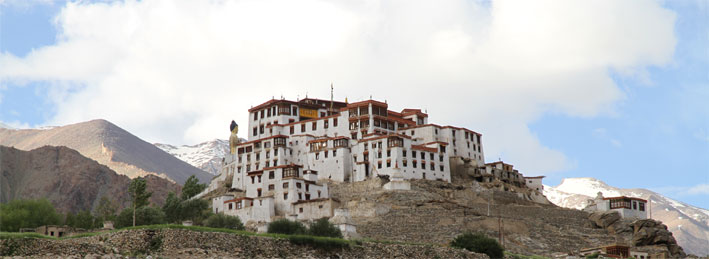
Culture of Ladakh
Ladakhi Food
Ladakhi Architecture
Ladakhi Monastery & Festivals
Ladakhi Music & Dance
Traditional Sports
Ladakhi Madicene
Culture of Ladakh
Culture of Ladakh is very similar to Tibetan culture. Ladakhi food has common with Tibetan food, the most prominent foods being thukpa (noodle soup) and tsampa known in Ladakhi as ngampe (roasted barley flour). A dish that is strictly Ladakhi is skyu, a heavy pasta dish with root vegetables. Tea in Ladakh is traditionally made with strong green tea, butter, and salt. It is mixed in a large churn and known as gurgur cha, after the sound it makes when mixed. Sweet tea (cha ngarmo) is common now, made in the Indian style with milk and sugar. Most of the surplus barley that is produced is fermented into chang, an alcoholic beverage drunk especially on festive occasions.
The architecture of Ladakh contains Tibetan and Indian influences and monastic architecture reflects a deeply Buddhist approach. The Buddhist wheel, along with two dragons, is a common feature on every gompa, including the likes of Lamayuru, Likir, Thikse, Hemis, Alchi and Ridzong Gompas. Many houses and monasteries are built on elevated, sunny sites facing south, and in the past were made of rocks, earth and wood but are now more often concrete frames filled in with stones or adobes.
The music of Ladakhi Buddhist monastic festivals, like Tibetan music, often involves religious chanting in Tibetan or Sanskrit as an integral part of the religion. These chants are complex, often recitations of sacred texts or in celebration of various festivals. Yang chanting, performed without metrical timing, is accompanied by resonant drums and low, sustained syllables. Religious mask dances are an important part of Ladakh's cultural life. Hemis monastery, a leading centre of the Drukpa tradition of Buddhism, holds an annual masked dance festival, as do all major Ladakhi monasteries. The dances typically narrate a story of the fight between good and evil, ending with the eventual victory of the former. Weaving is an important part of traditional life in eastern Ladakh. Both women and men weave, on different looms. Typical costumes include gonchas of velvet, elaborately embroidered waistcoats and boots and hats. The Ladakh Festival is held every year from September 1 to 15. Performers adorned with gold and silver ornaments and turquoise headgear throng the streets. Monks wear colorful masks and dance to the rhythm of cymbals, flutes and trumpets. The yak, lion and Tashispa dances depict the many legends and fables of Ladakh. Buddhist monasteries sporting prayer flags, display of thankas, archery competitions, a mock marriage and horse-polo are the some highlights of this festival.
The most popular sport in Ladakh now is ice hockey, which is played only on natural ice in January. Cricket is also very popular. Archery is a traditional sport in Ladakh, and many villages still hold archery festivals, which are as much about traditional dancing, drinking and gambling as about the sport. Polo, the other traditional sport of Ladakh is indigenous to Baltistan and Gilgit, and was probably introduced into Ladakh in the mid-17th century by King Singge Namgyal, whose mother was a Balti princess.
Tibetan medicine has been the traditional health system of Ladakh for over a thousand years. This school of traditional healing contains elements of Ayurveda and Chinese medicine, combined with the philosophy and cosmology of Tibetan Buddhism. For centuries, the only medical system which was accessible to the people has been the amchi who are traditional doctors following the Tibetan medical tradition. Amchi medicine is still an important component of public health to this day, especially in remote areas.
Other Ladakh Tour Packages :-





